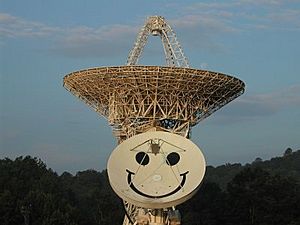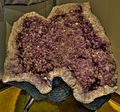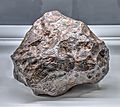Pisgah Astronomical Research Institute facts for kids
Quick facts for kids Pisgah Astronomical Research Institute |
|||||||||||||||||||||||||
|---|---|---|---|---|---|---|---|---|---|---|---|---|---|---|---|---|---|---|---|---|---|---|---|---|---|

Smiley with 26 West in the background
|
|||||||||||||||||||||||||
| Location | Balsam Grove, North Carolina | ||||||||||||||||||||||||
|
Coordinates
|
35°11′59″N 82°52′21″W / 35.1996°N 82.8724°W
|
||||||||||||||||||||||||
| Altitude | 2,999 feet (914 m) | ||||||||||||||||||||||||
| Established | January 1999 | ||||||||||||||||||||||||
|
|||||||||||||||||||||||||
The Pisgah Astronomical Research Institute (PARI), pronounced perry, is a special place in the Pisgah National Forest in Balsam Grove, North Carolina. It's a non-profit observatory where scientists and students study space. PARI uses many different radio telescopes and optical telescopes to learn about the universe. It's also connected to the University of North Carolina system.
Contents
History of PARI's Location
The land where PARI is located has an interesting past. In 1962, NASA (the National Aeronautics and Space Administration) built a station here. It was called the Rosman Satellite Tracking Station.
NASA's Space Tracking Station
This station was a key part of NASA's worldwide network. It helped NASA communicate with astronauts during important missions. These missions included Project Gemini and the Apollo program, which sent humans to the Moon.
Later Uses and New Beginnings
In 1981, the station was transferred to the National Security Agency (NSA). It was then known as the Rosman Research Station. The NSA used it for different purposes.
The NSA closed the station in 1995. For a few years, the site was not used. Then, in 1999, a group of scientists and business people formed a non-profit foundation. They bought the site and created PARI. They updated the equipment to use it for studying space. Today, professional astronomers and engineers work at PARI.
Learning and Research at PARI
PARI is a place for both research and education. Many universities work with PARI on study programs.
University Partnerships
Universities like Furman University, Clemson University, and Duke University partner with PARI. They conduct research and study programs together. PARI has also hosted important meetings for astronomers. These meetings help scientists share new discoveries.
Educational Programs for Students
PARI offers many educational opportunities for young people. It hosts programs like the Duke University Talent Identification Program. This program helps talented students explore their interests.
PARI also has a portable StarLab planetarium. This special dome lets people experience the night sky indoors. Over 40,000 people in Western North Carolina have enjoyed these astronomy programs.
Amazing Telescopes and Exhibits
PARI has many cool instruments and displays for visitors to explore.
Powerful Radio Telescopes
The main radio telescopes at PARI are two large 26-meter dishes. There's also a smaller 4.6-meter radio telescope called Smiley. These telescopes are used to track radio signals from space.
Smiley is special because it's used for remote teaching. Students from all over the world can learn astronomy using Smiley. The telescope got its friendly face around 1982. It was a fun way to greet surveillance satellites flying overhead.
Astronomical Plate Archive
PARI is home to the Astronomical Photographic Data Archive (APDA). This archive helps save old astronomical photographs. From the late 1800s to the 1980s, astronomers used glass plates to record data.
There are millions of these plates around the world. Many are at risk of being lost because there isn't enough storage space. APDA helps protect these important historical records.
Exhibit Gallery
The Exhibit Gallery at PARI has a fascinating collection. You can see rare meteorites and minerals. There are also artifacts from NASA Space Shuttle missions. Many of these items have actually been to space!
Images for kids
-
A Redstone rocket engine on display
-
Knightia fossils from the Green River Formation
-
Brazilian Amethyst
-
Agates collected between 1920 - 1950












